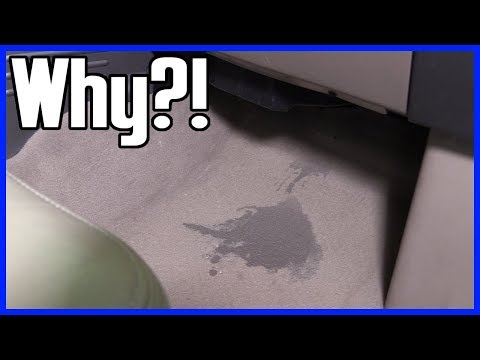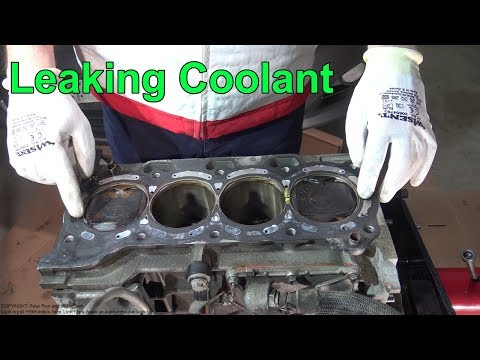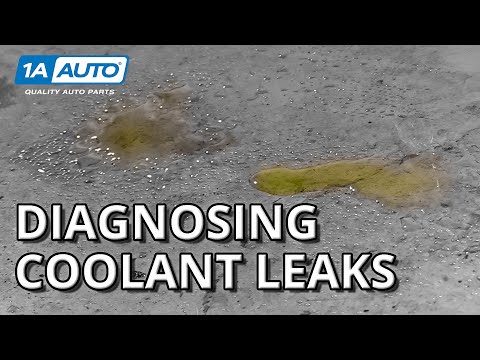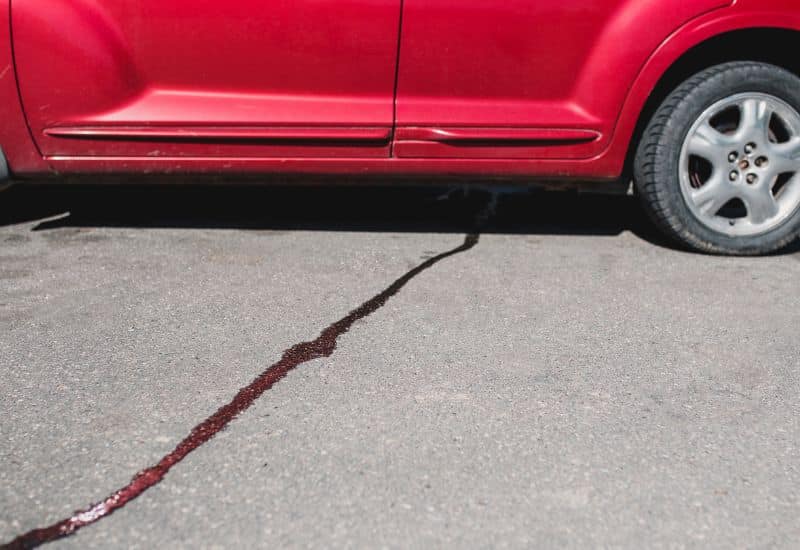
Nothing will stop your heart and have you check your bank account faster than finding a few drops or a nasty puddle of strange fluid under your car. Your mind reels as you try to remember what you learned all those years ago in the auto shop class.
Figuring out what’s leaking, why, and what you can do about it starts with assessing the color and location. Sometimes, you can double-check your theory by assessing the car’s various fluid levels.
The two most common fluid colors you’ll likely find under your car due to a mechanical fault are the bluish-black drops of an oil leak and the translucent green of antifreeze escaping the engine cooling system.
Of course, these are just the tip of the iceberg when deciphering what’s spattering under your engine bay. To find out what fluid is leaking out and if there’s a quick fix, we’ll have to look at its color and the leak’s location.
1. Water Near the Muffler or Tailpipe
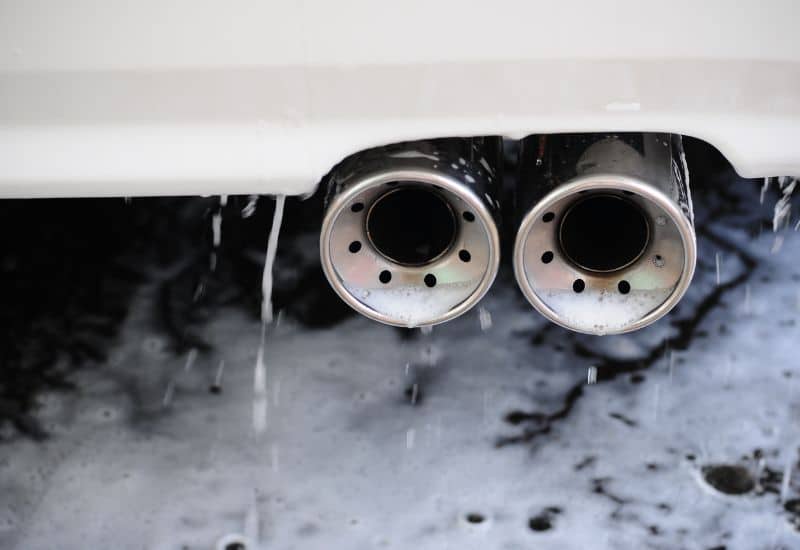
Clear fluid or water under the muffler or tailpipe is one of the more common perceived “Leaks” you’ll find under a car. Most of the time, this is just condensation from the exhaust system being expelled by the heat and onrush of the engine exhaust.
When to Be Concerned?
If it goes beyond a few seconds after engine startup, you should be concerned about water leaking from the muffler or tailpipe. Water leaking in constant drips or an occasional stream is often an early sign of a catalytic converter problem.
If you notice a tinge of white in your exhaust and a sweet smell, you might also have a head gasket that’s started to fail. This allows tiny amounts of water mixed with antifreeze to enter the cylinders and pass through the exhaust system.
Even if it’s just a few normal drops of water condensation under the car, you should still watch for signs of long-term rust at the muffler welds and the bottom of the muffler housing.
2. Clear Water Under the Engine Bay Near the Firewall
A pool of clear water under the car near the firewall between the cab and the engine bay is a commonly misperceived leak usually linked to air conditioner condensation. Just like how your AC at home drips in highly humid weather when it’s running, so does a car’s air conditioning.
This usually happens near the evaporator, where the refrigerant goes through a phase change, becoming cold. The surrounding ambient humidity becomes condensation, just like the outside of a cold pop can on a steamy July afternoon, and it drips down onto the pavement.
When to Be Concerned
If you’re seeing water droplets near the firewall and experiencing wet spots or dampness on the floor in the passenger footwell, your AC drain pan is clogged. It’s basically overflowing, and the condensation is escaping anywhere it can. However, this is usually easy to fix independently, as you just need to unclog the drain pan port.
3. Green, Teal, Orange, or Pink Near the Front of the Engine Bay
When you see green, blue-green, orange, or pink fluid dripping under the engine bay, it is almost always a sign of a leak in the engine coolant system. This is usually accompanied by the engine running overly hot and strange, sweet odors coming from inside the engine bay or possibly the exhaust system.
Though just where the drips are, the odors you’re getting and the volume being expelled will tell you where the fault lies.
Coolant Leak in the Front of the Engine Bay

If you’re getting a small volume of suspected engine coolant near the very front of the engine bay, it’s likely a problem with the thermostat sitting atop the radiator. You might even notice white residue and smudges on the top of the radiator where tiny amounts of fluid are evaporating.
If getting a large amount of fluid near the front of the engine bay, then it’s likely either a puncture in the radiator or a failure in one of the hoses connecting to the radiator. Carefully inspect the radiator while the engine is running to try to spot signs of an active leak.
Coolant Leak Behind the Radiator
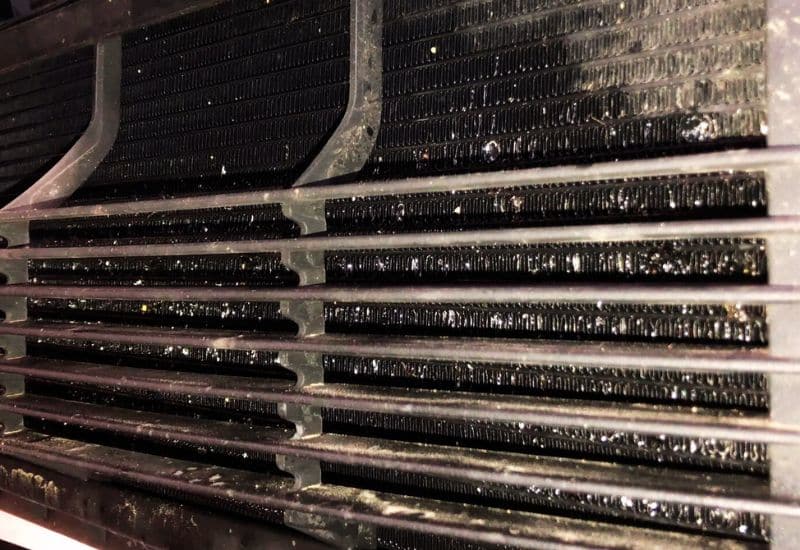
If the suspected coolant leak is behind the radiator, then you might be dealing with a leak on or in the water pump. This is the pump that drives the engine coolant system. It will also show signs of active leaking while the engine is running and hot.
Coolant Leak On Top and under the Engine Block
If you have coolant on top of your engine block and/or it rains down under it, it’s a strong sign that you have a cracked cylinder or badly blown head gasket. This allows coolant to escape, leaving green, teal, orange, or pink puddles all over the engine bay. In most of these cases, the coolant also gets into the cylinders, causing yellow, sweet-smelling smoke to come out of the exhaust system.
Coolant Leak near the Firewall
If you’ve got green, teal, orange, or pink fluid leaking under your car near the firewall, then the most likely fault is a leak in the heater core or one of the lines connecting to it. In a case like this, you’ll likely also notice that your heater has been putting out weak, warm air or perhaps blowing cold. You might also notice a strange, sweet smell from the vents.
4. Light Brown to Black
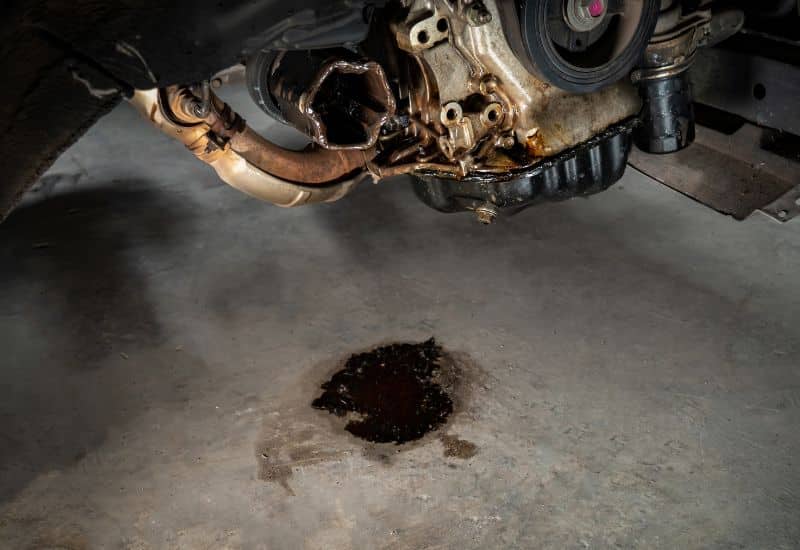
Light brown to black leaks under your car is one of the surest signs that you have an oil leak. This will usually be accompanied by other signs such as the engine running hot, the engine feeling down on power, and strange metallic rasping sounds. Low engine oil from a severe leak can also lead to misfires and the increasing risk of the engine seizing.
If just a little bit of light brown-to-black oil leaks, you might be able to top up the engine oil and drive home or to a mechanic. However, a more major leak means the car needs to be towed to safety.
Just how much oil is leaking and where it’s dripping out under the car will clue you in on the mechanical fault.
Oil Leaking Toward the Back of the Engine Bay
Oil leaking from the back of the engine bay is usually a rear main oil seal. When it fails, you usually get a large volume of oil expelled when the engine is running. However, it stops moments after you turn the car off.
It will often fall on the bell housing of the transmission and can leave what looks like two separate small puddles when it’s real, one very serious single oil leak from the failed rear seal.
Oil Leaking Toward the Front of the Engine Bay
If you see oil leaking from the front of the engine bay, then it could be that the front main oil seal is failing. One of the sure signs of a major oil leak like this one is that you usually end up with oil in the engine bay on the serpentine belt, pulleys, and other critical components like the alternator. The leak tends to be active when the engine is running but stops within a few seconds after you shut the car off.
Oil Leaking Directly Under the Engine
If you have small to medium-sized oil spots directly under the engine, regardless of whether the car is running or not, then the leak is likely around the oil pan or the oil filter. It could also be the oil pan drain plug. Spotting where the oil leaks usually starts with wiping everything down with a bunch of clean shop rags. Then, check the oil. Assuming it’s low, put a little bit in and watch to see where the leak is coming out the strongest.
5. Red or Brown Fluid Leaks
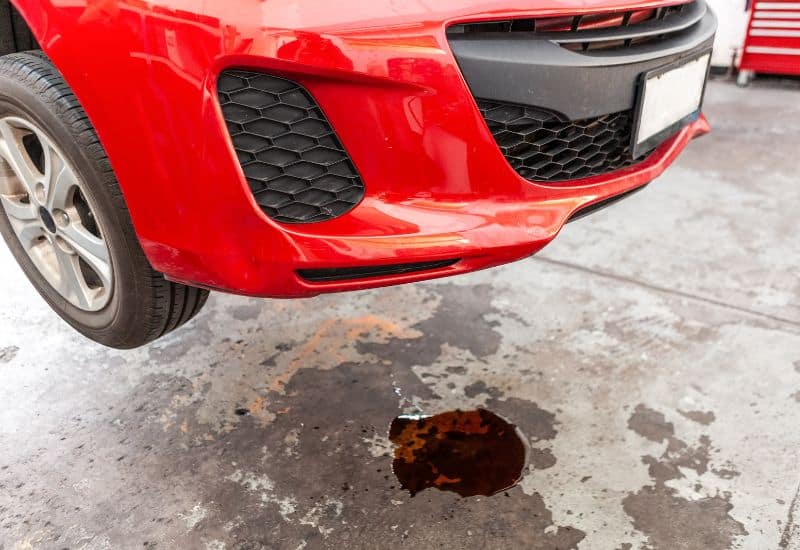
Red or brown fluid leaks that feel oily to the touch are almost always transmission fluid. Depending on the severity of the leak, you might also notice the transmission making a whining noise, hesitation in the gear changes, and possibly even gear grinding. If the transmission leak is severe or the fluid level has drastically lowered, the car might get stuck in gear or slip out of first gear after just a few hundred feet.
It’s also worth noting that power steering fluid also looks reddish-brown. However, when you touch it and rub your fingers together, it won’t have near the oily feel of transmission fluid.
With a transmission fluid leak, there’s a real danger of causing expensive damage if you keep driving on it. If you need to get home or to the mechanic, you can check the transmission fluid and add more in small doses. Once you get to safety, the wise move is to park it.
Unfortunately, transmission leaks tend to be fickle as the fluid loves to migrate along surfaces before finally dripping off. The location, volume, and the effects on transmission performance will all clue you in on where the leak is and what you need to do about it.
Transmission Fluid Toward the Front of the Engine Bay
When you have red or brown transmission fluid dripping toward the front of the engine bay, it’s usually a leak in the bell housing, the seal with the torque converter, or the front input shaft. With this type of leak, you’ll see transmission fluid coming out when the engine is running, and it will express with the most pressure right at gear changes. Then, when you stop the car and turn it off, it will only leak for a little while until the internal fluid reaches the level of the leak or failed seal.
Transmission Fluid Under or Around the Transmission Oil Pan
Reddish-brown fluid immediately under the transmission and/or the engine is one of the most common types of transmission leaks. These leaks are often active whether the engine is running or not. While the transmission oil pan or the dipstick gasket can be damaged, the most common culprit is likely a failed transmission oil pan gasket.
With a leak like this, you’ll find fluid under the transmission and alongside the oil pan, but the top of the oil pan will still be dry. You might also notice one bolt that’s been overly tightened, deforming the transmission oil pan flange just enough to let fluid leak out.
Transmission Fluid Toward the Front of the Engine Bay
Anytime you see a reddish-brown fluid leak toward the front of the engine bay, you have to suspect a leak in one of the cooling lines running to and from the radiator. In a case like this, you might notice the transmission has been running a little hot; the fluid might even have a dark tinge to it, indicating the heat is breaking it down. The transmission fluid on the dipstick might only be a little low, as these leaks often start out very small.
Transmission Fluid on the Back of a Tire
A front-wheel-drive car with reddish-brown transmission fluid on the back of a tire or a wheel hub likely leaks one of the axle seals. These leaks tend to be more pronounced when the car is driving down the road and then vanishes just a few seconds after you stop. By the time you notice the transmission fluid leak on your driveway, it’s probably gotten to the point where it’s a bad idea to drive the car any further.
6. Light Yellow to Dark Brown Near a Wheel or on a Tire
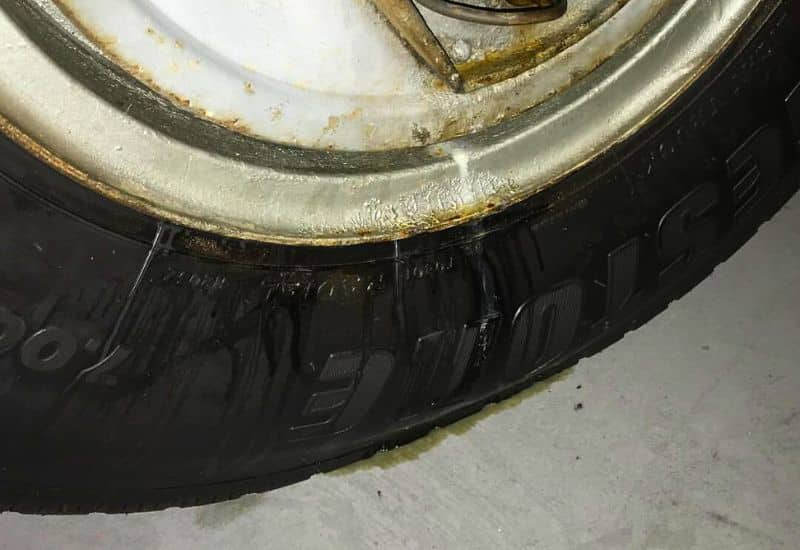
Light yellow to brown fluid leaks near a wheel or dripping off the backside of a tire when parked is usually a sign of a brake fluid leak. This is usually a brake line that’s failed, and it’s equalizing the pressure when parked. However, the wheels aren’t the only place where you might notice a yellowish-brown brake fluid leak.
Regardless of where it leaking, yellowish-brown brake fluid leaks mean the car is unsafe to drive. You’ll likely even get a red brake warning light on the dash telling you the entire brake system is compromised.
Brake Fluid Under the Firewall
If you’re seeing yellowish-brown brake fluid near the firewall, it likely means that something has failed on the brake master cylinder or the brake fluid reservoir. With a leak like this, you’ll usually notice that your brake pedal feels spongy, and your braking distance is increasingly poor.
Brake Fluid Coming Out of the Frame
If you have brake fluid coming out of the frame or one of the undercarriage rails near a wheel, it’s likely a brake line leak or the coupler connection between the brake line and the hose leading to the caliper. You can confirm this type of leak by starting the engine and having someone pump the brakes. You’ll literally see the fluid spraying out under pressure from the point of failure.
Brake Fluid or Pooling Under a Tire
Yellowish-brown brake fluid pooling under or on a tire usually indicates a problem with the hydraulic brake lines inside a caliper. With a leak like this, you might have also noticed the car pulling hard to one side when braking and perhaps even grinding brake noises.
7. Clear with oily feel or Reddish pink-Brown Fluid Toward the Front of the Engine
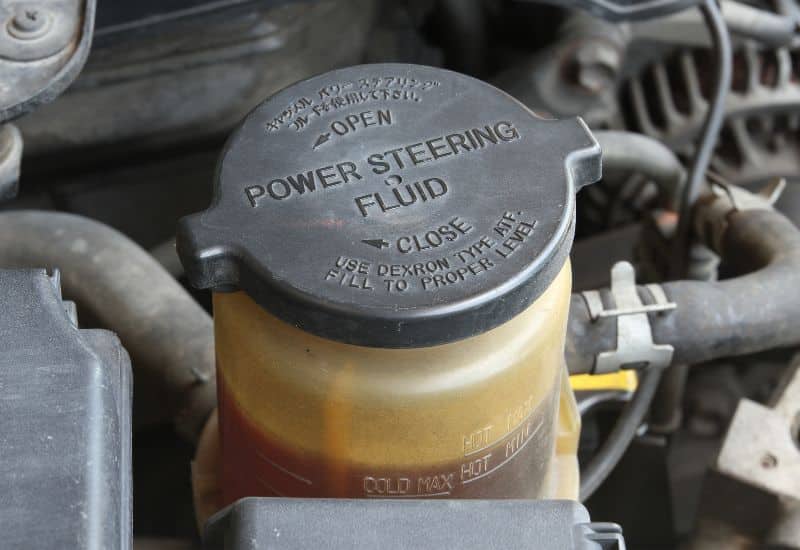
Clear with oily feel or Reddish pink-Brown Fluid with a thin viscosity that you find toward the front of the engine bay usually indicates some sort of power steering fluid leak. It looks very much like transmission fluid but won’t feel as oily between two rubbed fingers.
You’ll likely also see the car’s steering feeling increasingly tough, especially as you turn the wheel toward the lock position. If the volume of Clear with oily feel or Reddish pink-Brown Fluid is significant, you’ll likely hear the power steering pump whining and might even see frothy bubbles in the reservoir.
Technically, you can drive with low-power steering fluid, as you’ll essentially have manual steering. However, you will get into hairy situations when cornering at low speed. Also, driving without the lubricating properties of power steering fluid can kill the power steering pump.
How to Find a Power Steering Fluid Leak
Power steering fluid that leaks onto the garage floor is usually centralized in a single reddish-brown puddle. Yet, finding where the leak is coming from might not be so easy. Finding the source can be vexing if you aren’t seeing the power steering fluid gushing out of the pump housing or drizzling out of the high-pressure line hose.
Golden to Golden-Brown Fluid
Golden to golden brown fluid is indicative of a differential leak. In a rear-wheel drive car, this is usually at the vehicle’s backend, right underneath the “Pumpkin” of the differential. However, it can be in other places around the housing. You might also notice a whining, humming, or grinding noise. The car might turn stiffly around corners, and the outside rear tire might “Bark” or “Chirp” as it skips to try to keep up with the turn.
Differential fluid plays a critical role in how a rear-wheel-drive car negotiates turns. The longer you drive with low fluid or a differential that’s essentially “Dry” inside, the more expensive the damage will be to the backend.
A Quick Look Over The Fluid Colors
Fluid Color | Types Of Fluid | Possible Source |
Clear and watery | Water | Air conditioning condensation, external source |
Green, teal, pink or orange | Coolant/antifreeze | Radiator, water pump, hoses, reservoir |
Light Brown to Black | Engine oil | Engine, oil pan, oil seals, gaskets |
Red or brownish-red | Transmission fluid | Transmission, cooler lines, seals |
Light Yellow to Dark Brown | Brake fluid | Brake lines, master cylinder, wheel cylinders |
Clear with oily feel or Reddish pink-Brown Fluid | Power steering fluid | Power steering pump, hoses, reservoir |
Golden to Golden-Brown Fluid | Differential fluid (rear-wheel-drive car) | Differential, seals, gasket |
Hold onto your hats, folks! There are a few more fluid mysteries to unravel, Dive in below!
Frequently Asked Questions
How do I remove vehicle fluid stains from my garage floor or driveway?
Most vehicle fluids have some type of oil base, which means you should be able to at least reduce them with a paste of laundry detergent and baking soda. Leave the paste on the concrete or asphalt for at least 15 to 20 minutes before spraying it off. This will give the soap time to break down the oil, and the baking soda can bond with it on its microscopic nucleation sites.
What color is a gasoline leak?
Gasoline leaking from a fuel line or a fuel tank crack will look like water. It will also make a colorful rainbow pattern if it drops onto a puddle of water or a wet surface. However, the most obvious sign will be the gasoline fuel odor, which requires maximum safety precautions.
Conclusion
Finding a puddle or drips of any color under your car is certainly concerning. You can usually use the color and location of the leak to determine the source with at least a ballpark guess of how serious it is.
A little bit of water under the car coming from the exhaust system is to be expected, as are a few small drops near the firewall from the air conditioning system. If you’ve got a lot of water from the AC and moisture in the passenger side footwell, you might have a clogged AC drain pan.
It likely indicates a coolant leak if you see green, teal, orange, or perhaps pink fluid under the engine bay. The farther forward the leak is, the more likely it has something to do with the radiator or the thermostat. The further back it is, the more likely there’s a problem with the water pump.
Brown to black drops or puddles usually indicate an oil leak. If it’s toward the back of the engine, it could be a rear main oil seal failing. It’s more toward the front and easier to work with the front main oil seal. However, it’s also possible for brown oil stains to pool under the car from a leak in the oil pan area.
Reddish-brown fluid can be transmission fluid or power steering fluid. However, transmission fluid feels more oily when you rub it between your fingers. Power steering fluid will only be found in the front under the steering system. At the same time, transmission fluid can migrate over surfaces and can even be found dripping from the axle seals behind the wheels of a front-wheel-drive car.

Written By
Jason Farrell
Jason Farrell is a certified master technician, the editor of Mechanic’s Diary in Pittsburgh, Pennsylvania. He is ASE (Automotive Service Excellence) certified and earned a Bachelor’s Degree in Automotive Technology from Pittsburg State University. With nearly 18 prior years of experience in the automotive field, he has extensive knowledge about Domestic, European, and other foreign makes and models of cars and light trucks. Jason’s experience working as a technician and service manager at dealerships, gave him the experience and know-how of most aspects of inspection, diagnosis, and repair from engine and drivability to electrical, HVAC, brakes, steering and suspension and everything in between.

